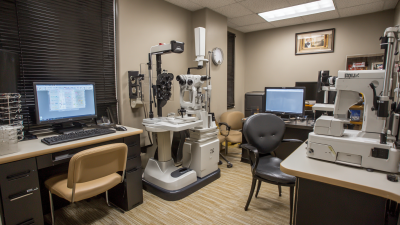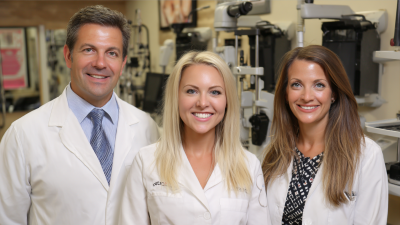Revolutionizing Vision Care: The Future of Ophthalmic Equipment and Technology
The field of ophthalmology is undergoing a significant transformation, driven by advancements in ophthalmic equipment and technology that promise to enhance patient care and outcomes. With the global ophthalmic devices market projected to reach $60 billion by 2025, the demand for innovative solutions is more pressing than ever (Research and Markets, 2020). Modern ophthalmic equipment, ranging from diagnostic tools to surgical instruments, is integrating cutting-edge technologies such as artificial intelligence and telemedicine.

These innovations not only aim to improve the accuracy of diagnoses but also to streamline procedures and enhance patient accessibility to eye care. As we look to the future, the emphasis on patient-centric technology and the increasing prevalence of eye diseases highlight the necessity for ongoing evolution in ophthalmic equipment. This evolution is crucial for addressing the rising global burden of vision-related disorders, which are expected to affect over 2.7 billion individuals by 2020 (World Health Organization).
Innovative Technologies Shaping the Future of Ophthalmic Equipment
The landscape of vision care is undergoing a significant transformation, driven by innovative technologies that are enhancing the capabilities of ophthalmic equipment.
Advanced diagnostic tools, such as optical coherence tomography (OCT) and intelligent imaging systems, are enabling practitioners to visualize the intricate structures of the eye with unprecedented clarity.
These technologies allow for early detection of ocular diseases, facilitating timely intervention and improved patient outcomes.
Moreover, the integration of artificial intelligence (AI) into ophthalmic practices is revolutionizing the way data is analyzed and interpreted.
AI algorithms can rapidly process vast amounts of patient information, assisting clinicians in making accurate diagnoses and personalized treatment plans.
Telemedicine applications are also emerging, providing remote consultation and monitoring, thereby increasing access to eye care for patients in underserved areas.
As these innovative technologies continue to evolve, they will undoubtedly shape the future of ophthalmic equipment, making vision care more efficient, accessible, and effective than ever before.

Integration of Artificial Intelligence in Vision Diagnosis and Treatment
The integration of artificial intelligence (AI) in ophthalmic equipment is transforming vision diagnosis and treatment, paving the way for advancements that enhance patient care. According to a 2021 report by Grand View Research, the AI-driven ophthalmology market is expected to reach approximately $3.27 billion by 2028, growing at a compound annual growth rate (CAGR) of 34.1%. This growth is fueled by the increasing prevalence of eye diseases and the demand for early diagnosis and personalized treatment options.
AI algorithms can analyze vast datasets faster and more accurately than traditional methods, enabling practitioners to detect conditions such as diabetic retinopathy, glaucoma, and age-related macular degeneration at earlier stages. A study published in JAMA Ophthalmology revealed that AI tools could outperform human specialists in diagnosing retinal diseases, highlighting their potential to reduce diagnostic errors and improve patient outcomes. As these technologies continue to evolve, their integration into routine eye examinations could lead to more precise treatments and a significant reduction in healthcare costs.
Advancements in Telemedicine for Enhanced Eye Care Accessibility
Telemedicine is transforming ophthalmic care by improving accessibility for patients who may otherwise struggle to receive timely eye examinations. Recent studies show that nearly 80% of vision loss can be prevented or treated, yet many patients face barriers such as distance to healthcare providers and limited appointment availability. Advancements in telemedicine are addressing these challenges by offering remote consultations and screenings, allowing patients to receive care from the comfort of their homes. According to a report by Allied Market Research, the global teleophthalmology market is projected to reach $1.2 billion by 2026, highlighting the growing demand for these services.
Tips: If you're considering a telemedicine service for your eye care needs, ensure that the platform is equipped with the necessary diagnostic tools for accurate assessment. Always check the credentials and experience of the healthcare provider to ensure you receive quality care.
Moreover, integrating artificial intelligence with telemedicine platforms has the potential to enhance diagnostic accuracy. AI algorithms are being utilized to analyze retinal images, predicting eye diseases with impressive precision. As reported by McKinsey, up to 90% of common eye conditions can potentially be diagnosed through enhanced telemedicine technologies, paving the way for a future where eye care is more proactive and accessible.
Tips: Regularly schedule virtual check-ups to keep track of your eye health, especially if you have pre-existing conditions. Staying proactive can significantly reduce the risk of severe vision impairment.
Smart Wearable Devices: Transforming Patient Monitoring and Engagement
The emergence of smart wearable devices is fundamentally transforming patient monitoring and engagement in the field of ophthalmic care. These innovative technologies, ranging from smart glasses equipped with augmented reality features to contact lenses that track biometric data, enable patients to maintain a proactive role in their health management. Wearable devices can continuously collect critical data, such as intraocular pressure and visual acuity, allowing for real-time insights into an individual’s ocular health. This shift from reactive to proactive care facilitates early detection of conditions like glaucoma or macular degeneration, ultimately improving patient outcomes.
Moreover, these devices enhance patient engagement by fostering a more interactive relationship with healthcare providers. Through mobile applications linked to wearable tech, patients can easily share their health data, receive personalized feedback, and adhere to prescribed treatment plans. This connectivity not only empowers patients with relevant information but also encourages them to take ownership of their health journey. As smart wearables continue to advance, they hold the promise of elevating the standard of care in ophthalmology, promoting a more engaged and informed patient population.
Revolutionizing Vision Care: The Future of Ophthalmic Equipment and Technology
| Device Type | Key Features | Patient Benefits | Monitoring Capabilities |
|---|---|---|---|
| Smart Glasses | Real-time data display, Object recognition | Enhanced navigation, Augmented reality assistance | Eye tracking, Visual field testing |
| Smart Contact Lenses | Glucose monitoring, Real-time alerts | Continuous health monitoring, Improved diabetes management | Blood sugar levels, Scleral pressure |
| Wearable Eye Trackers | High-speed tracking, Data analytics | Improved focus, Enhanced engagement | Gaze direction, Duration of fixation |
| Telehealth Platforms | Video consultations, Remote monitoring tools | Access to specialists, Convenience for patients | Vision assessments, Follow-up care |
The Role of Big Data and Analytics in Ophthalmology Research and Treatment Solutions
The advent of big data and analytics is transforming the landscape of ophthalmology, enabling breakthroughs in both research and patient care. Recent reports indicate that approximately 2.6 billion people globally suffer from myopia, with the youth in China reaching a staggering prevalence rate of 52.7%. These alarming statistics emphasize the pressing need for innovative treatment solutions and the role of data-driven insights in addressing this epidemic. Advancements such as light therapy, recently discovered by researchers from Hong Kong, exemplify how targeted treatments can help reverse the progression of myopia, demonstrating the tangible benefits of leveraging analytics in vision care.
Moreover, the integration of artificial intelligence into ophthalmic research is creating new paradigms for data utilization. For instance, AI-driven tools can enhance early detection rates of diabetic eye diseases, which currently remain below 10% among the over 100 million diabetic patients in China. With AI playing a pivotal role in medical research, the ability to analyze large datasets and derive meaningful conclusions is accelerating drug development and improving diagnostic accuracy. These advancements signal a brighter future for ophthalmology, where big data not only refines research methodologies but also transforms treatment protocols for improved patient outcomes.

Related Posts
-

8 Powerful Reasons to Choose the Best Optometry Equipment for Your Practice
-

How to Choose the Right Optometry Equipment for Your Practice Success
-

Ensuring Global Compliance in Lens Cleaner Spray Production Standards
-

Understanding the Versatility of Glasses Chain for Modern Accessories
-

Exploring Market Trends for Blocking Pads at the 138th Canton Fair in 2025
-

Top Strategies for Enhancing Practice Efficiency with Optometry Equipment
